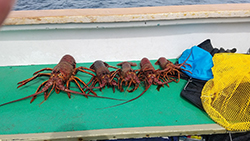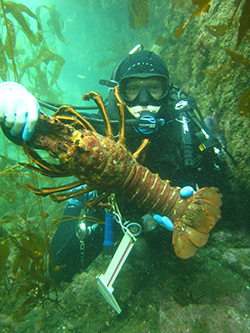

The April 30 deadline to turn in California spiny lobster report cards is fast approaching – and CDFW needs your catch data!
The information collected from these is enormously helpful to CDFW scientists who monitor the harvest, amount of fishing effort and the gear used in the recreational fishery. Although CDFW has considerable information about the commercial lobster fishery from landing receipts and logbooks, there was very little reliable information on the magnitude of the recreational lobster catch and fishing effort prior to the launch of the lobster report card program.
CDFW first began requiring lobster fishers to fill out and turn in harvest report cards 10 years ago, in the 2008-2009 season. Persons taking or trying to take lobsters were required to possess, fill out and submit spiny lobster report cards at the end of the season.
By the 2013-2014 sport fishing season, CDFW rolled out a new spiny lobster report card system with new reporting requirements to improve the estimates of the recreational fishery harvest. The new reporting requirements included a non-return penalty fee if cards were not returned at the end of the season. Since then, card return rates have improved greatly. It could be argued that the new reporting requirements encourage more people to return their lobster report cards, which in turn has improved estimates of sport lobster catch and effort.
Results determined from report card returns after the 2017-2018 season showed a 50 percent return rate of more than 16,000 cards, compared to 22 percent (approximately 6,000 cards) after the 2008 season. In 2017-2018, more than 85,000 lobsters were reported kept versus nearly 48,000 reported in 2008. Based upon the numbers from 2017-2018, more than 171,000 lobsters were estimated taken by the recreational fishery. When added to the recorded commercial harvest for this season, recreational fishermen accounted for 31 percent of the entire California spiny lobster harvest for the season.
The cost for this year’s spiny lobster season report cards was $9.27 when purchased from CDFW offices, with a small (about 2%) surcharge applied when purchased from other vendors. Report cards are available in most places where sport fishing licenses are sold, including tackle shops and sporting goods stores, or can be purchased online. The funds raised by the sale of lobster cards are earmarked for CDFW projects, including those specifically focused on the lobster fishery.
Daily bag and possession limits are seven lobsters per person. No more than one daily bag limit may be taken or possessed by any one person unless otherwise authorized, regardless of whether they are fresh, frozen or otherwise preserved. This means that if you have a limit of seven lobsters at home, you cannot go out and get more lobsters until the first limit is disposed of in some way (eaten, given away, etc).
People often ask why commercial fishermen are allowed to use huge traps while recreational fishermen are restricted to using hoop nets. Many think this doesn’t seem fair, but CDFW is mandated by law to allow for the sustainable use of lobster by both the commercial and recreational fishing sectors. While our laws say that recreational fishermen are entitled to harvest for sport (and not subsistence use), commercial fishermen must make a living off the resource. The commercial lobster industry is highly regulated, with a fixed number of permits, and commercial fishermen are required to use traps with strict regulations concerning mesh size and escape ports that allow large numbers of sub-legal sized lobsters to come and go freely from traps. Recreational lobster fishing is considered a sport and not meant for subsistence.
CDFW would like recreational users to enjoy this resource. The number of recreational participants is not restricted, and hoop nets and diving are both very effective methods of recreational take. Finally, there are large productive areas that are closed to commercial lobster fishing but open to recreational lobster fishing, such as Santa Monica Bay, San Pedro Bay, San Diego Bay, the lee side of Catalina Island and many bays and jetties.
###
Some interesting facts about these popular crustaceans: California spiny lobsters are believed to live 50 years, or more! The males have been recorded up to three feet long and weighing 26 pounds. Today, lobsters over five pounds are considered trophy-sized. For more information on spiny lobster biology, please check out our  California Spiny Lobster brochure (PDF).
California Spiny Lobster brochure (PDF).
CDFW Photos.
Media contacts:
Carrie Wilson, CDFW Communications, (831) 649-7191
Kirsten Macintyre, CDFW Communications, (916) 322-8988